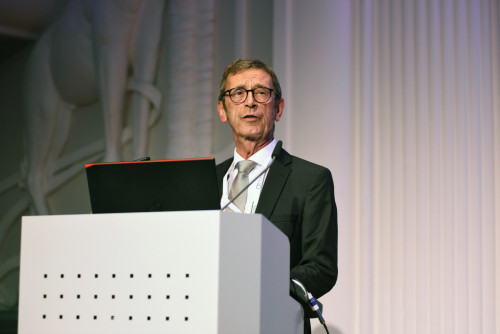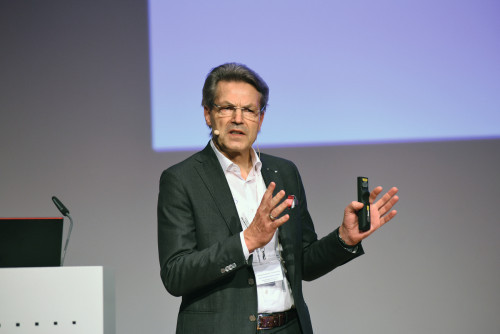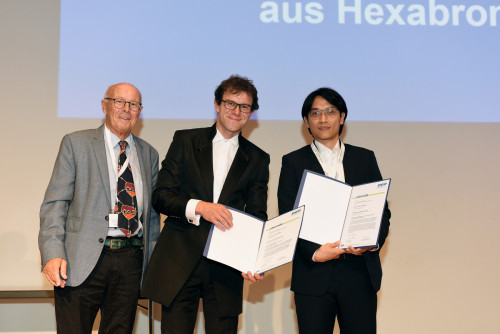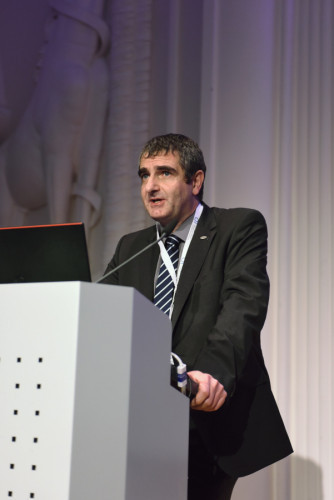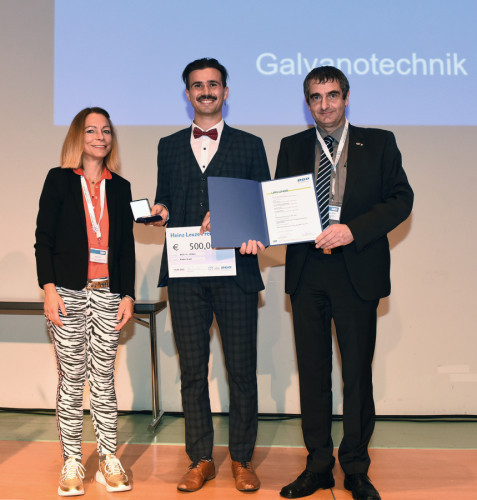- Part 1 - This year's Surface Days in Leipzig were dominated by the massive rise in energy costs. However, attendance was very good, not least because the 90 presentations covered almost every relevant topic in the industry. The introductory evening was marked by honors, award ceremonies for specialist publications and pioneering developments as well as a keynote speech on recyclable materials and surfaces for the ISS.
Meetings and conferences are exhausting and exhausting - but at the same time inspiring and exciting, as scientists, entrepreneurs and suppliers come together in one place to exchange knowledge, solve current problems and welcome and integrate new members into the select circle of the industry in a quasi-interdisciplinary manner. The top event in electroplating and surface technology is known to be the Surface Days, which took place this year from September 14-16 in the German "electroplating capital" of Leipzig. In the coverage of the last in-person event of the Surface Days before Corona in September 2019, the then editor-in-chief of Galvanotechnik, Heinz Käsinger, asked that politicians and their empty phrases be avoided at the event. And lo and behold, that's exactly what happened at the first Surface Days after the end of the pandemic: politics were left out and the focus was placed on the essentials in these difficult times - technology, networking and solution expertise, and by no means to the detriment of the event.
Good attendance - large trade exhibition
On the introductory evening in the congress hall at Leipzig Zoo, ZVO Chairman Walter Zeschky was initially pleased with the good turnout. 515 participants had come to Leipzig, as well as 65 exhibitors at the accompanying trade exhibition. In his welcoming address, the entrepreneur and association representative mentioned, among other things, the 20 prospective electroplating technicians who had come to Leipzig with Volker Rogoll from the Technical College for Electroplating in Schwäbisch Gmünd. He then introduced the keynote speech by Prof. Frank Mücklich, Head of the Institute for Functional Materials at Saarland University.
Hygienic surfaces for space travel
Prof. Mücklich addressed several important topics for surface technology: The recyclability of metals from waste, the importance of functional coatings and the necessary consideration for the environment. After all, living nature manages with 28 elements, whereas we now technically use 70 elements that are only returned to the cycle to a limited extent, he explained. He illustrated the need to recycle metals with the impressive example that every smartphone contains 30 mg of gold, for which 1 tonne of rock has to be extracted. Prof. Mücklich concluded his presentation with the topic "About recyclable materials - and why we are sending them into space". Surface technology is currently also playing an important role on the International Space Station (ISS). In the small ecosystem of the space station, pathogenic bacteria are a danger to astronauts. An antimicrobial surface was developed using laser structuring, which ESA astronaut Matthias Maurer tested on the ISS. Attached to a disk, all astronauts had to touch the surface. As a result, germs were reduced by 80 % with the help of the functional layer. The technology is therefore likely to be suitable for implant surfaces, for example, as Prof. Mücklich suggested.
Pioneering technologies receive prizes
This was followed by numerous awards and honors. First on the agenda was the Leipzig Electroplating Award 2021. It was awarded to a group of companies and universities, consisting of Chemnitz University of Technology, Chair of Materials and Surface Technology, the electroplating plant manufacturer OTE Oberflächen- und Elektrotechnik Scheigenpflug GmbH and the company KleRo GmbH Roboterautomation. You can find out more about the award-winning project in the interview with Claudia Wagner from Leipzig-based OTE Oberflächen- und Elektrotechnik Scheigenpflug GmbH on p. 1350.
Prof. Wolfgang Paatsch then presented the DGO Young Talent Award to Dr. Johannes Näther from Mittweida University of Applied Sciences for his dissertation on "The electrodeposition of iridium from hexabromoiriidate complexes". The German Society for Electroplating and Surface Technology (DGO) also awarded an honorary membership. It went to Rainer Venz from ESI Automotive, an expert in electroplating technology in electromobility, among other things, who is also active in the German Surface Technology Association (ZVO). The laudatory speech for Venz was given by Dr. Martin Metzner, recently re-elected Chairman of the DGO.
Another central award ceremony was the Heinz-Leuze Prize, which went to a group of scientists from the Research Institute for Precious Metals and Metal Chemistry (fem) in Schwäbisch Gmünd (see box). Before the music started and the buffet was opened, Kyu Hwan Lee from the Korean Institute of Material Science addressed a few words of welcome to the industry. Lee was part of a Korean delegation that is currently exploring opportunities for cooperation with German scientists. These include decorative chromium (III) deposits, bath chemistries without cyanide and the industrial use of metal deposits in ionic liquids (more on this in the interview on p. 1412).
 DGO honorary member Rainer Venz (left) with DGO Chairman of the Board Dr. Martin Metzner
DGO honorary member Rainer Venz (left) with DGO Chairman of the Board Dr. Martin Metzner
Uncertainty due to high energy prices
The Surface Technology Days were characterized throughout by the uncertain situation on the energy markets. After all, electroplating and surface technology is an energy-intensive industry which, as a supplier sector, cannot easily pass on its own price increases to customers. The concerns were therefore palpable.
In the run-up to the event, Andrea Thoma-Böck from Thoma Metallveredlung in Heimertingen had also commented in the Bild newspaper on the dramatic situation in the industry caused by energy prices. The ZVO had also written an urgent letter on the situation to Economics Minister Robert Habeck. At short notice, an energy forum was therefore also arranged at the Surface Days to provide industry companies with advice and facilitate an exchange of ideas. You will find a report on this in Part 2 of the report in the November issue.
Galvanotechnik" held numerous discussions on the subject on the fringes of the conference, during which calls were made for an energy price cap, for example. Depending on the size of the company, electroplating plants can incur additional costs of up to one million euros. ZVO boss Zeschky spoke of an increase in the proportion of energy costs from the current 10 % to up to 25-30 % per company. However, the companies are not burying their heads in the sand or limiting themselves to complaining about the situation. For example, the representative of an anode manufacturer that has been operating its furnaces with natural gas to date reported on the imminent switch to propane gas.
One of the four sessions on the first day of the event was entitled "Entrepreneur Forum: Management meets surface", one of the four sessions on the first day of the event dealt with topics relevant to entrepreneurs. One topic was presented by Dr. Nina Dambrowsky from Siemens AG in Berlin.
Decommissioning a hazardous incident plant with extended obligations - how to say goodbye to 70 years of electroplating
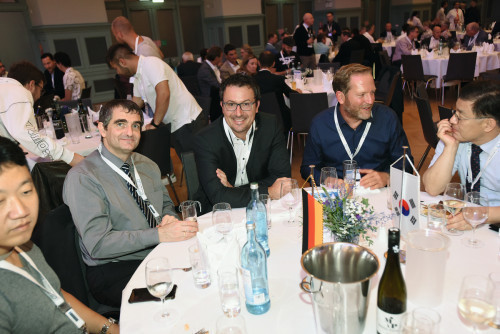 German and Korean experts are working together to identify synergies in research. A Korean delegation also took part in the Surface DaysSiemensAG has been producing on the site in Berlinsince1897; contract electroplating has existed for 70 years. As part of the Siemensstadt Berlin urban district development, a technology-driven, sustainable, integrative urban district is to be created on the historically characterized industrial site. The hazardous waste plant no longer fitted into this concept and so Siemens AG decided with a heavy heart to close this electroplating plant. The decision was made on 15.07.2019 and everything was to be completed by 30.09.2021. This presented the team with a challenging task: operations had to be shut down in just two years in accordance with the BImschG. First of all, a carve-out of various coating technologies with over 3,000 items had to take place, as well as a technology transfer of in-house developments. The coating of over 3,000 components had to be relocated to other electroplating plants. In order to ensure the continued quality-compliant coating of these items, potential electroplating plants had to be sounded out via sample coatings and audits with the proviso that all processes were relocated by 30.08.2020. One particular challenge was to qualify the AgC process developed at Siemens AG in another electroplating plant. According to Dambrowsky, the transfer of decades of experience was secured and the coating of all components was relocated on schedule thanks to the prudent carve-out.
German and Korean experts are working together to identify synergies in research. A Korean delegation also took part in the Surface DaysSiemensAG has been producing on the site in Berlinsince1897; contract electroplating has existed for 70 years. As part of the Siemensstadt Berlin urban district development, a technology-driven, sustainable, integrative urban district is to be created on the historically characterized industrial site. The hazardous waste plant no longer fitted into this concept and so Siemens AG decided with a heavy heart to close this electroplating plant. The decision was made on 15.07.2019 and everything was to be completed by 30.09.2021. This presented the team with a challenging task: operations had to be shut down in just two years in accordance with the BImschG. First of all, a carve-out of various coating technologies with over 3,000 items had to take place, as well as a technology transfer of in-house developments. The coating of over 3,000 components had to be relocated to other electroplating plants. In order to ensure the continued quality-compliant coating of these items, potential electroplating plants had to be sounded out via sample coatings and audits with the proviso that all processes were relocated by 30.08.2020. One particular challenge was to qualify the AgC process developed at Siemens AG in another electroplating plant. According to Dambrowsky, the transfer of decades of experience was secured and the coating of all components was relocated on schedule thanks to the prudent carve-out.
In her further remarks, the speaker described the dismantling of the plants and the remediation of pollutants in the contaminated area and explained the problems and difficulties that arose. For example, there were various accidents during demolition, gas development and hydrogen cyanide alarms. The logical consequence of this was that all work was carried out with gas masks.
Thanks to the close cooperation of all the trades involved, the initial project delays were made up for and the schedule was adhered to. The recycling and disposal of all waste was carried out in accordance with the BImschG, so that no harmful effects on the environment occurred. A damage-free initial state was restored. The listed building was gutted and handed over on the target date to ensure that the site could be reused in the interests of the urban quarter. The former galvanizing plant building is to be used for social purposes.
Two presentations in this thematic block dealt with fire protection. New sources of danger were presented, as well as the insurance perspective.
Loss of production due to fire damage: Will anything change now?
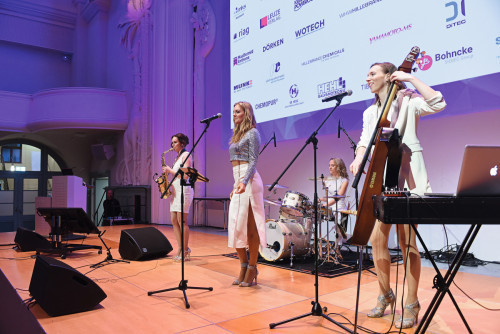 This band provided suitable musical accompaniment at the end of the eveningSpeakerDieter Lenzenhuber from MacDermid Enthone Industrial Solutions gave an update on preventive fire protection in electroplating and surface technology in his presentation, particularly in light of the fact that up to 80 fires occur in electroplating production facilities every year, with ten to twelve major fires. In his presentation, he addressed various sources of danger and pointed out particular problem areas. Newer supporting technologies for preventive fire protection are
This band provided suitable musical accompaniment at the end of the eveningSpeakerDieter Lenzenhuber from MacDermid Enthone Industrial Solutions gave an update on preventive fire protection in electroplating and surface technology in his presentation, particularly in light of the fact that up to 80 fires occur in electroplating production facilities every year, with ten to twelve major fires. In his presentation, he addressed various sources of danger and pointed out particular problem areas. Newer supporting technologies for preventive fire protection are
- Olfactory detection (warning system in the event of overheating due to reactivated odor)
- Device and control cabinet-integrated electrical isolation and extinguishing technology (extinguishing cartridges)
- Sensor-controlled monitoring of live system components.
A proven supporting technology is the use of heat exchangers instead of electric heating. Reference books can also be very helpful in providing advice. And the focus should always be on the "human factor". The principle of the "emergency response map" has proved its worth as an aid to employees in the event of malfunctions, accidents, emergencies and fires. This contains a clear and prioritized sequence of measures designed to support the user in dealing with a critical situation within the first few minutes. It must be available to every employee and must also be available at critical workstations and interfaces.
STPA (System-Theoretic Process Analysis), a relatively new hazard analysis technique, can also help to improve safety. According to STPA, accidents occur not only due to the failure of components, but also due to unsafe interactions between system components, none of which may have failed.
In the end, Lenzenhuber was able to answer his initial question: "Production loss due to fire damage, will anything change now?" with a clear yes. Yes, things can change if technology, organization and the human factor are coordinated. Investment in technology + planning/analysis of the organization + training of the human factor means the highest potential for damage limitation.
Fire protection measures for fire and fire business interruption insurance
Florian Nowack, BüchnerBarella Holding GmbH & Co KG, continued the topic of fire protection from the perspective of the property insurance market. Recent major fire losses have increased the pressure on the property insurance market enormously. Insurers are reacting by reducing capacity, increasing prices (surcharges of up to 30% are expected at the beginning of the year) and not underwriting individual risks. The requirements for fire protection are increasing. The following trends are emerging:
- Thermographic testing
- Insulation resistance measurement (continuous monitoring of insulation resistance using a permanently installed differential current measurement)
- Targeted fire protection directly on the system using object extinguishing systems (as an alternative to sprinkler systems)
- Object extinguishing systems based on high-pressure fog extinguishing technology.
Insurers' thinking is characterized by major fires. However, adequate fire protection ensures insurability in the long term.
INFO
Heinz-Leuze Prize: Article on functional coating wins the race
This year's Heinz-Leuze Prize goes to four scientists from the Research Institute for Precious Metals and Metal Chemistry fem in Schwäbisch Gmünd. Robin Arnet, Dr. Ann-Kathrin Egetenmeyer, Herbert Kappl and Dr. Heidi Willing will receive the 1000 euro prize and a solid silver medal for a publication on silver dispersion coatings with self-lubricating properties, which was published in the January 2021 issue of the journal Galvanotechnik.
The prize has been awarded since 1985 for a publication in a specialist journal in German-speaking countries with a particularly clear and didactic presentation of an important technical-scientific problem.
From next year, the prize money will be doubled to 2000 euros, making the prize one of the most highly endowed awards in the industry.
The laudatory speech for this year's Heinz-Leuze Prize was given by Prof. Andreas Bund, Head of the Department of Electrochemistry and Electroplating at Ilmenau Technical University. In his speech, Prof. Bund expressed his expectation that silver dispersion coatings with integrated lubricant particles will be of particular importance in the upcoming age of electromobility, as these coatings are particularly suitable for use in current-carrying connections in electrical energy technology. The forward-looking coating technology was also discussed by the authors with the deposition and characterization of silver coatings with graphite, hexagonal boron nitride, MoS2, WS2, Bi2S3 and SnS2 at a high scientific level and in a very well didactically prepared manner. The fem researchers followed a methodically and logically very well-structured experimental program, he affirmed. The aim of the experiments was to incorporate the various particles homogeneously and agglomerate-free into a silver matrix with volume fractions of 10 %.
Prof. Bund praised the authors for their excellent contributions to the enhancement of galvanic processes for future-oriented applications in electrical energy technology. Robin Arnet accepted the prize on behalf of the four authors from Prof. Andreas Bund and Britta Kraft, the granddaughter of the publisher Heinz Leuze, who died in 1983.


